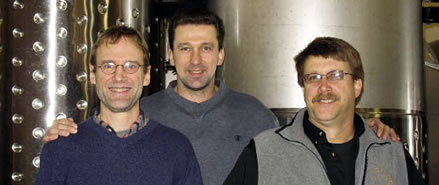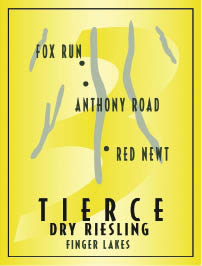
|
|
PRINT » |
|
|
E-MAIL THIS PAGE » |
|
|
CLOSE THIS WINDOW » |
Feature Article from the June 2009 Magazine Issue
A Study in Riesling
How three winemakers collaborate on Tierce in the Finger Lakes

The concept of Tierce began in late winter 2005, when the three vintners--Johannes Reinhardt of Anthony Road, Peter Bell of Fox Run and Dave Whiting of Red Newt--met for a tasting of their 2004 Riesling lots. They each had numerous lots from different vineyards, press fractions and yeasts from which they would make their own individual wines. Whiting explained, "It was our primary goal to take some time to taste, discuss and share knowledge and experiences about our practices and perspectives of winemaking…that is making Riesling in particular. We had a great, informative tasting, and at some point Reinhardt said, 'We should make a wine together!' We thought it sounded like a lot of fun, and felt it could be educational as well, so we did it. Over the next few months, multiple tasting and blending sessions yielded our first vintage--2004 Tierce."
Anthony Road
Reinhardt, who has been head winemaker at Anthony Road since 2000, tries to spend about three weeks cluster thinning in late July and early August. By the end of August he taste tests grapes twice each week, looking for focus and elegance, not wanting the fruit to be fat, plump or broad. The magic word for Reinhardt is balance. Grapes for the trio's Tierce are chosen according to development, not site, and his key is acid backbone.
His grapes average between 7.5 and 9.5 g/L of acid, depending upon vintage. In 2007, an uncommonly warm and dry year, fruit came in as low as 7 g/L. If the grapes get too close to 10 g/L, they show too much acid impact and exhibit coarser, grassy elements. Improved vineyard management techniques, along with vine maturity, enable Anthony Road Rieslings to exhibit greater depth and complexity while aging better, according to Reinhardt.
In making his Riesling, Reinhardt in some cases chooses to macerate for up to 24 hours. In 2008, the grapes began to macerate and went directly from the bins to press via conveyor. Pressing is determined by taste, with an average of 2 to 2.5 hours with a gentle cycle. Reinhardt said, "I want to see flesh on its bones," with a touch of sweet fruit, especially for aging purposes. The fruit flavor profile ranges from ripe pear to peach to mango. He has changed his philosophy on sweetness in the last four years, allowing a bit more residual sugar while treating the grapes more gently in processing. Reinhardt will sometimes change the production style depending upon the vintage. Like his Tierce "brothers," he employs intuition and experience to determine style and finish.
Reinhardt did numerous lot trials for complexities in blend-backs, and the resulting 2008 dry Riesling went into a 1,200-gallon tank, 170 gallons of which will go into the 2008 Tierce.
Fox Run
Peter Bell, winemaker at Fox Run for 14 years, believes that Finger Lakes Riesling can handle cool seasons with some wet conditions, but hot weather and drought can undermine the grape's structure. He looks for flavor and acid structure more than specific numbers--a finely tuned structure showing austerity, and wisps of fruit flavors like lime peel and nectarine wrapped around a spine of acid. By no means does he ignore the numbers: He likes sugars at 19.5? Brix, and acids at 8 to 9 g/L.

Bell begins blending as early as late November, or as late as early May, depending upon tank space and other production considerations. The range of tank sizes is from 500 to 3,000 gallons. Prior to blending, he separates the best expression for a reserve wine. The final determination of residual sugar and what becomes a reserve wine is not based upon numbers. "I trust organoleptic experiential informati on rather than analysis," said Bell, known by his peers as a particularly sensitive taster.
Although he prefers his reserve Riesling to be dry, the 2006 reserve Riesling was done in a sweeter style, because it was the best expression of the grape that harvest. Bell also doesn't decide beforehand what level of residual sugar he wants; rather, he takes the end results of his earlier decision-making. Fox Run Dry Riesling can have up to 9 to 10 g/L of residual sugar, but the crisp acids found in the grapes offer good balance. The other expression, labeled as Riesling, averages about 20 to 25 g/L of residual sugar. The 2008 harvest provided about one-third dry Riesling and two-thirds Riesling, producing a total of about 3,000 cases.
Red Newt
Dave Whiting, owner and winemaker at Red Newt, has three ripeness parameters when working with Riesling. The first and foremost is flavor development, with fruit expressions ranging from lemon sour to tangerine, and finally apricots. He likes to pick grapes in the middle of that range, which gives him flexibility in the flavor development. The next parameter is fruit condition. Separating grapes that show a loss of integrity because of rot, or choosing ripe fruit with the additional complexity that comes from botrytis cinerea are such examples. Finally, there is the chemistry of the fruit.
In his perfect world, Whiting would get Riesling harvested at 21° Brix, acid at 9 g/L, and pH of 3.05. These factors interplay in different ways in different years, and when Whiting looks to produce a reserve Riesling, the ripeness can be as high as 22°-23° Brix, as long as it still has a focused acidity that will support the resulting 12%-13% alcohol. He also can use press fractioning to adjust the levels of acidity and pH.
Within a day or two of completing fermentation, Whiting will add about 65ppm sulfur. He also likes to stir the lees, sometimes during fermentation, and anywhere from two weeks to two months later on the finer lees. The wine is aged in 500-gallon tanks for the vineyard-designated lots, and 2,000- to 3,000-gallon tanks for the regular Riesling. The latter product is usually first released about four weeks after bottling, and is scheduled for an early April debut.
He patterns his regular bottling to have crisp acidity, and anywhere between 1% and 3% residual sweetness. The reserve and vineyard designated Rieslings tend to be drier, with more structure, exhibiting "complexity underpinned with fruit." His leaner dry and vineyard designated Rieslings, however, will "always taste better after two or three years," Whiting said.
2008 Tierce
When the first Tierce was in the planning stages, there was only a single rule. Each winery would contribute exactly one-third to the total. This remains the only rule used when making this wine, although Whiting said, "If it came down to it in a given vintage and we couldn't do it, we'd break the rule." After their first two vintages in 2005 and 2006, the collaborators became comfortable with the process that brought them to a dry, complex, structured wine. They look at the individual characteristics of each winery's Riesling, and try to put together a blend that shows the individualities yet creates a more complete synergy as a whole.
"If you taste hard enough, you can identify the three individual style components that went into it," Whiting said. The three main fruit components, according to Whiting, are lemons from Fox Run, Clementine oranges from Red Newt, and peaches from Anthony Road.
The three winemakers and their assistants sat down in December to begin the process with about 36-40 lots of their 2008 Rieslings. After tasting and discussing the wines, the group narrowed the range to two lots from each winery. When they met again they fine-tuned the possible combinations. "The key at this point is not selecting the best stand-alone wines to include in the blend," Whiting said, "but rather to select wines that have great attributes that are likely to work together."
He continued, "The next step is to see how the wines play with each other--where some of the real differences in strategy comes in."
Each winery has a main and secondary component, the combination totaling about 150 gallons for each winery. The sampling, which took three half-days of tasting and discussions, resulted in identifying the minor component, or "spice," as they call it, for each winery, the main component of each and finally, the best combination of the six parts. For the 2008 Tierce, Fox Run's "spice" is about 14% of their contribution, while Red Newt's minor component was only 7% of their contribution. The wines were combined in late January to late February, and held in a tank at Fox Run. Fining trials followed the marrying of the lots, and the fined blend was tasted again after another five to seven days.
I had the opportunity to taste the components from each winery, and detected the following characteristics: Bell's main contribution was austere, with a backbone of lemony acid that dominated, yet continued in a very long, lemony finish. His "spice" was much more tropical, broader on the nose and palate.
Whiting's primary component exhibited ripe fruit reminiscent of Clementine oranges, rich yet focused. His "spice" was also on the tropical side, yet had an appealing, somewhat unusual quince character. Finally, Reinhardt's main component exhibited an elegant floral bouquet, with bright tangerine and peach flavors, combined with good length. I was unable to sample his "spice" for this article.
Bell feels that their Tierce is "a metaphor for how winemakers in the Finger Lakes work together." Whiting agreed, saying, "It expresses the vintage, but more moderately," as opposed to how any single Riesling might. Reinhardt, given credit by his "Tierce brothers" for the birth of this enduring collaboration, said, "All the Riesling we bring to the table has focus, elegance and acid backbone." He believes the wines in Tierce reflect the very best that the three wineries produce. "As a team you can make a stronger statement," he said, adding, "We don't do this to gain fame or make money. We do it because it's a pleasure to make Riesling and enjoy a great friendship."
Available only at the three wineries, Tierce comes packaged in an extra-tall 750ml bottle with screwcap closure and sells for $30.
Ithaca, N.Y.-based Ray Pompilio is a 26-year veteran of the w ine industry. Contact him at raypomp@twcny.rr.com. To comment on this story, write edit@winesandvines.com.
|
|
PRINT » |
|
|
E-MAIL THIS ARTICLE » |
|
|
CLOSE THIS WINDOW » |
